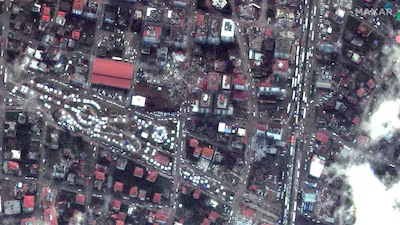Follow the latest on the earthquake in Turkey and Syria
Satellite images of Turkish towns affected by the earthquake show the horrifying extent of the devastation, with homes flattened by the quake to leave neighbourhoods unrecognisable.
Thousands of buildings have collapsed across Turkey, with nearly 13,000 people now confirmed dead in the country. More than 3,000 have died in Syria.
Rescuers are losing hope of finding more survivors buried under rubble.
Satellite images from Maxar Technologies show how the quake has affected those living in Antakya, in Turkey's southern Hatayn province, as well as communities in Islahiye and Nurdagi, in Gaziantep province.
Antakya
Hatay was the province hit hardest by what was the biggest quake to strike the country since 1939.
Provincial capital Antakya was a thriving multicultural hub, but the destruction caused by the tremor means the city is now unrecognisable.
The images show razed buildings and areas reduced to rubble and emergency tents.
At least 1,200 buildings have been destroyed in the city’s Kirikhan and Iskenderun districts, BBC Turkey reported.
Islahiye
Images of Islahiye show homes flattened, some with their roofs almost intact, amid piles of rubble.
Bulldozers can be seen clearing debris as rescue teams search for survivors.
Nearby roads are filled with vehicles used to ferry rescue teams to the destroyed neighbourhoods.
Teams worked through Tuesday night and into Wednesday morning across the country, pulling bodies from the rubble of destroyed homes.
About 380,000 people have taken refuge in government shelters or hotels, the authorities said.
“It’s like we woke up to hell,” said Osman Can Taninmis, whose family members were still missing beneath the rubble in Hatay province.
“Help isn’t coming, can’t come. We can’t reach anyone at all. Everywhere is destroyed.”
With so many buildings destroyed by the quake, many survivors in Turkey have had to sleep in cars, outside or in government shelters, AP reported.
“We don’t have a tent, we don’t have a heating stove, we don’t have anything. Our children are in bad shape. We are all getting wet under the rain and our kids are out in the cold,” said Aysan Kurt, 27.
“We did not die from hunger or the earthquake, but we will die freezing from the cold.”
Nurdagi
Images of the city of Nurdagi, Gaziantep province, near the epicentre of the earthquake, show emergency services set up around damaged homes and warehouses.
One image from the satellite showed a football stadium in nearby Kahramanmaras converted into a tented city for aid response.
Duzce
In the city of Duzce, in Osmaniye province in the Mediterranean region of Turkey, emergency tents fill green spaces between buildings after makeshift camps were set up to help those affected by the quake.
Turkish President Recep Tayyip Erdogan on Tuesday declared a state of emergency in 10 provinces.
He said 13 million of the country’s 85 million people have been affected by the quake.
As many as 23 million people could be affected in Turkey and Syria, said Adelheid Marschang, a senior emergencies officer with the World Health Organisation.
He called it a “crisis on top of multiple crises”.




